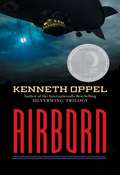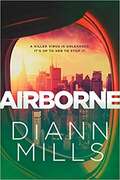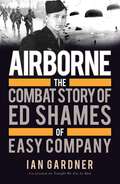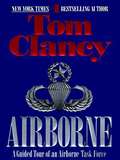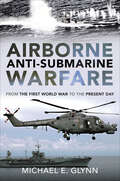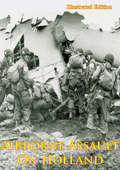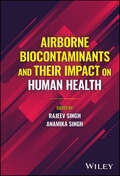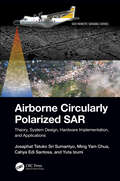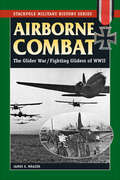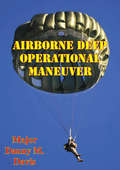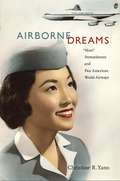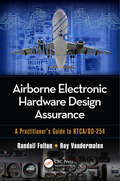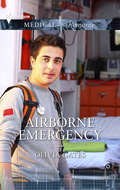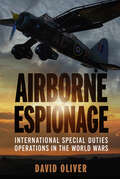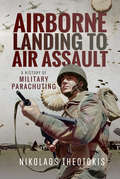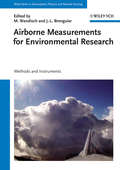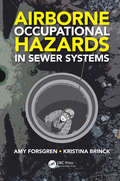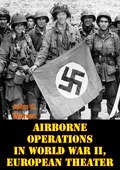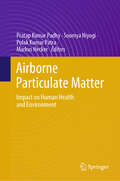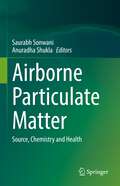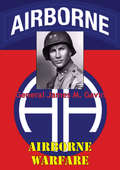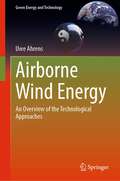- Table View
- List View
Airborn
by Kenneth OppelSailing toward dawn, and I was perched atop the crow's nest, being the ship's eyes. We were two nights out of Sydney, and there'd been no weather to speak of so far. I was keeping watch on a dark stack of nimbus clouds off to the northwest, but we were leaving it far behind, and it looked to be smooth going all the way back to Lionsgate City. Like riding a cloud. . . .Matt Cruse is a cabin boy on the Aurora, a huge airship that sails hundreds of feet above the ocean, ferrying wealthy passengers from city to city. It is the life Matt's always wanted; convinced he's lighter than air, he imagines himself as buoyant as the hydrium gas that powers his ship. One night he meets a dying balloonist who speaks of beautiful creatures drifting through the skies. It is only after Matt meets the balloonist's granddaughter that he realizes that the man's ravings may, in fact, have been true, and that the creatures are completely real and utterly mysterious. In a swashbuckling adventure reminiscent of Jules Verne and Robert Louis Stevenson, Kenneth Oppel, author of the best-selling Silverwing trilogy, creates an imagined world in which the air is populated by transcontinental voyagers, pirates, and beings never before dreamed of by the humans who sail the skies.
Airborne
by DiAnn MillsHeather Lawrence’s long-awaited vacation to Salzburg wasn’t supposed to go like this. Mere hours into the transatlantic flight, the Houston FBI agent is awakened when passengers begin exhibiting horrific symptoms of an unknown infection. As the virus quickly spreads and dozens of passengers fall ill, Heather fears she’s witnessing an epidemic similar to ones her estranged husband studies for a living - but this airborne contagion may have been deliberately released.
Airborne
by Ian GardnerCol. Ed Shames is that rare man who can call himself a true warrior. A member of Easy Company of Band of Brothers fame, Shames saw combat in some of the most ferocious battles of WW2. From jumping behind the lines of Normandy on D-Day with the 101st Airborne Division, to the near victory of Operation Market Garden, to the legendary stand at Bastogne during the Battle of the Bulge, Shames fought his way across Europe and into Germany itself.In Airborne Shames and writer Ian Gardiner (Tonight We Die as Men) tell the gripping true story of what it was like to be at the spear point of WW2 in Europe. Neither the book nor TV series of Band of Brothers ever showed the real Ed Shames. Although he started as a private, combat soon forged Shames into a tough and inspired leader who would win a battle field commission in Normandy. Seemingly to always be where the fighting was, his two goals were to prevail in each fight with the Germans, and to keep his men alive. "Shames, you are the meanest, roughest son of a bitch I've ever had to deal with. But you brought us home," was the highest compliment he received from one of his men.Even though he was wounded in the Ardennes, Ed Shames never stopped fighting until Germany surrendered and the war was won. He has never stopped being a warrior.
Airborne
by Tom ClancyThey are America's front lines--serving proudly in forward areas around the world. Representing the very best from the Army and Air Force, the Airborne Task Force is an unstoppable combination of manpower and firepower. Now, Tom Clancy examines this elite branch of our nation's armed forces. With pinpoint accuracy and a style more compelling than any fiction, the acclaimed author of Executive Orders delivers an fascinating account of the Airborne juggernaut--the people, the technology, and Airborne's mission in an ever-changing world... * Two Tom Clancy "mini-novels"--real world scenarios involving the airborne task force * Airborne's weapons of the 21st century, including the Javelin anti-tank missile, the fiber-optically guided N-LOS fire support system, and the Joint Strike Fighter * 18 weeks: Life in an Airborne Alert Brigade * Exclusive photographs, illustrations, and diagrams PLUS: An in-depth interview with the incoming commander of the 18th Airborne Corps, General John Keen
Airborne Anti-Submarine Warfare: From the First World War to the Present Day
by Michael GlynnThis military history explores more than a century of aerial submarine hunting, from WWI through the Cold War and beyond. U. S. Navy veteran Michael Glynn served as a submarine hunting pilot. Now he chronicles the evolution of this unique combat role from the Great War through the Battle of the Atlantic in World War II and on to secret Cold War confrontations. He traces the parallel evolution of both aircraft and submarine as each side tries to gain advantage. Through his expert analysis, Glynn distills complicated oceanography, operations analysis, and technical theory, helping the reader understand how complex weapons and sensors function. He also examines submarine hunts in action, showing how theory and practice work together to help aviators detected their targets.
Airborne Assault On Holland [Illustrated Edition] (Wings At War #4)
by AnonIllustrated with 4 maps and 2 Illustrations.Airborne Assault on Holland highlights the role of air power as the Allies attempted to penetrate German defenses at the Siegfried Line. The work reflects the circumstances of the time and the desire to find good even in unfortunate circumstances and should be read with this in mind. Allied airborne paratroops and glider-borne units converged on Arnhem. Unfortunately, stiff German resistance forced their eventual withdrawal; Allied tactical air power prevented even heavier friendly losses, but could not turn defeat into victory. This boldly conceived operation involved the Eighth and Ninth Air Forces in a variety of missions: troop transport, fighter escort, flak neutralization, air cover, and resupply of ground forces.
Airborne Biocontaminants and their Impact on Human Health
by Rajeev Singh Anamika SinghExplore in-depth the relationships between biological contaminants and human health found in diverse settings such as homes, hospitals, businesses, and schools Indoor air quality has an immense impact on human health and well-being. Indoor air environments can contain a huge range of biological contaminants, including bacteria, fungi, viruses, insects, and their various harmful byproducts. Indoor biocontamination has been under-studied as an aspect of public and occupational health, and there is an urgent need for an introduction to this vital subject. Airborne Biocontaminants and Their Impact on Human Health meets this need with a thorough, rigorous overview of major indoor airborne contaminants. Gathering and summarizing a huge range of data regarding biocontaminants in settings from homes to schools to workplaces, it investigates patterns of morbidity and their connections to major contaminants. The result is an essential tool in the broader fight for human health at home and elsewhere. Airborne Biocontaminants and Their Impact on Human Health readers will also find: Analysis of the indoor role of gases, particulate matter, and others Detailed coverage of contaminant byproducts including endotoxins, mycotoxins, volatile organic compounds, and more Methods for generating awareness and therefore reduced risk of exposure to harmful contaminants Airborne Biocontaminants and Their Impact on Human Health is ideal for researchers—biologists, environmentalists, civil and environmental engineers, industrial hygienists, safety regulators, and public health officials—interested in the area of biological contamination in different environments.
Airborne Circularly Polarized SAR: Theory, System Design, Hardware Implementation, and Applications (SAR Remote Sensing)
by Josaphat Tetuko Sri Sumantyo Ming Yam Chua Cahya Edi Santosa Yuta IzumiA comprehensive resource on airborne synthetic aperture radar (SAR) systems, Airborne Circularly Polarized SAR explains the theory, system design, hardware and software, and applications of airborne circularly polarized SAR in environmental monitoring and other uses. Readers learn how to build the hardware and software of circularly polarized SAR, the antenna system, and how to generate point target responses and images using the range doppler algorithm (RDA) from raw signal data. The book discusses applications and analyzing techniques using a circularly polarized SAR system and image processing. Images and MATLAB® codes are provided to help professionals and researchers with their applications and future studies. Features 1. Provides the theory of circularly polarized wave and polarimetry related to system design, scattering analysis, polarimetric SAR, and applications in microwave remote sensing. 2. Explains the real radio frequency (RF) system and the original antenna, including circuit explanation and know-how of measurement technique to adjust to the required parameter in system design. 3. Discusses the technique of ground test and flight mission to calibrate and validate the performance of airborne circularly polarized SAR. 4. Highlights image signal processing with MATLAB codes and how to obtain a single look complex (SLC) image for further applications. 5. Includes several applications of airborne circularly polarized SAR from international leading experts. This book is beneficial to professionals, researchers, academics, and graduate students from disciplines such as Electronic Engineering; Radar Systems; Aerospace Engineering; Signal Processing; Image Processing; Environmental Remote Sensing.
Airborne Combat: The Glider War / Fighting Gliders of WWII (Stackpole Military History Series)
by James E MrazekStories of WWII&’s elite glider troops and their combat operations, including Eben Emael, Normandy, Bastogne during the Battle of the Bulge, and more. Long pursued by civilian thrill seekers and dare devils, airborne gliding came of age during World War II as one of that conflict&’s most dangerous combat operations. The armed forces of Axis and Allied nations developed gliders—wooden aircraft that bursts of flak could shred and a poor landing could smash—and flew them into battle at Eben Emael, Crete, Normandy, Arnhem, and Bastogne. James E. Mrazek&’s riveting account brings to life both the men who carried out these perilous missions and the gliders that proved vital to the success of airborne attacks.
Airborne Deep Operational Maneuver
by Major Danny M. DavisThe purpose of this paper is to answer two questions. The first question is: Is it feasible to use airborne forces to penetrate enemy airspace and to conduct a vertical envelopment to effect deep operational maneuver? If it is feasible, what are the employment options available for the use of such an airborne force in the conduct of a modern military campaign? To examine these questions, the paper begins with some definitions to provide a common frame of reference. The use of airborne forces in World War II is next examined to determine if the use of airborne forces to effect deep operational maneuver is historically feasible. Next, the contemporary threat is discussed as it is relevant to the employment of airborne forces in a modern context. Next, the feasibility of the use of airborne forces with some limitations to conduct deep operational maneuver is established in the context of the maneuver, firepower, and protection aspects of the combat power model. Next, the theory of deep operations and the use of airborne forces to conduct these kinds of deep maneuvers is examined in the theories of Clausewitz, Jomini, Tukhachevskiy, Triandafillov, and Simpkin. Next, six employment options for the use of airborne forces to conduct deep operations in a modern context are deduced. They are: (1) an airborne force can be used to create a second front within a theater of operations; (2) an airborne force can be used to operationally contain an enemy force targeted for destruction within a theater of operations; (3) an airborne force can be used to seize a "bridgehead"...; (4) an airborne force can conduct coups de main against high value targets within a theater of operations; (5) an airborne force can conduct light operations in a theater of operations to disrupt and disorganize the enemy's rear facilities and networks and have a cumulative operational impact; and (6) an airborne force can conduct expeditionary operations to achieve political, strategic, and operational aims
Airborne Dreams: "Nisei" Stewardesses and Pan American World Airways
by Christine YanoIn 1955 Pan American World Airways began recruiting Japanese American women to work as stewardesses on its Tokyo-bound flights and eventually its round-the-world flights as well. Based in Honolulu, these women were informally known as Pan Am's "Nisei"--second-generation Japanese Americans--even though not all of them were Japanese American or second-generation. They were ostensibly hired for their Japanese-language skills, but few spoke Japanese fluently. This absorbing account of Pan Am's "Nisei" stewardess program suggests that the Japanese American (and later other Asian and Asian American) stewardesses were meant to enhance the airline's image of exotic cosmopolitanism and worldliness. As its corporate archives demonstrate, Pan Am marketed itself as an iconic American company pioneering new frontiers of race, language, and culture. Christine R. Yano juxtaposes the airline's strategies and practices with the recollections of former "Nisei" flight attendants. In interviews with the author, these women proudly recall their experiences as young women who left home to travel the globe with Pan American World Airways, forging their own cosmopolitan identities in the process. Airborne Dreams is the story of an unusual personnel program implemented by an American corporation intent on expanding and dominating the nascent market for international air travel. That program reflected the Jet Age dreams of global mobility that excited postwar Americans, as well as the inequalities of gender, class, race, and ethnicity that constrained many of them.
Airborne Electronic Hardware Design Assurance: A Practitioner's Guide to RTCA/DO-254
by Randall Fulton Roy VandermolenWritten by a Federal Aviation Administration (FAA) consultant designated engineering representative (DER) and an electronics hardware design engineer who together taught the DO-254 class at the Radio Technical Commission for Aeronautics, Inc. (RTCA) in Washington, District of Columbia, USA, Airborne Electronic Hardware Design Assurance: A Practitioner's Guide to RTCA/DO-254 is a testimony to the lessons learned and wisdom gained from many years of first-hand experience in the design, verification, and approval of airborne electronic hardware. This practical guide to the use of RTCA/DO-254 in the development of airborne electronic hardware for safety critical airborne applications: Describes how to optimize engineering processes and practices to harmonize with DO-254 Addresses the single most problematic aspect of engineering and compliance to DO-254—poorly written requirements Includes a tutorial on how to write requirements that will minimize the cost and effort of electronic design and verification Discusses the common pitfalls encountered by practitioners of DO-254, along with how those pitfalls occur and what can be done about them Settles the ongoing debate and misconceptions about the true definition of a derived requirement Promotes embracing DO-254 as the best means to achieve compliance to it, as well as the best path to high-quality electronic hardware Airborne Electronic Hardware Design Assurance: A Practitioner's Guide to RTCA/DO-254 offers real-world insight into RTCA/DO-254 and how its objectives can be satisfied. It provides engineers with valuable information that can be applied to any project to make compliance to DO-254 as easy and problem-free as possible.
Airborne Emergency
by Olivia GatesFasten your seatbelts … turbulence ahead!<P> Surgeon Cassandra St. James can’t wait to join the Global Aid Organization’s new flying Jet Hospital. Nothing could be more thrilling and challenging … until she encounters mission leader Vidal Santiago.<P> What is this millionaire plastic surgeon, the man she loves and loathes, doing on a humanitarian mission? Has Cassandra misjudged him? And can the jet-setting surgeons control the unwanted passion that flares between them?
Airborne Espionage: International Special Duties Operations in the World Wars
by David OliverOperating in all weathers, invariably at night, often at low level and usually without fighter escort, Allied ‘Special Duties’ (SD) squadrons and units played a vital role in the Second World War. By their very nature, these operations went unreported in wartime and for considerable time thereafter, but their importance in prosecuting the war of resistance in Occupied Europe was immense.Emerging from a time of rudimentary communications and transport, dedicated air units had been established by 1939 to fly agents into enemy territory, but their aircraft were hand-me-downs and the SD was considered a poor third to fighter and bomber operations. However, the tasks undertaken by these men and their aircraft were often more hazardous and demanding than any other type of wartime flying: for every SOS, SIS or OSS agent who lost their life in the field, at least one RAF or USAAF airman was killed while flying SD operations.Here, David Oliver examines the exploits of British, Commonwealth, American, Free European, Soviet, German, Italian and Japanese airmen and units, supported by first-hand accounts and archive photographs.
Airborne Express
by Jan W. RivkinIn the wake of a highly successful quarter, senior managers of Airborne Express, the third largest player in the express mail industry, review the firm's competitive position. Airborne has survived, and recently prospered, in an industry with significant economies of scale even though it is much smaller than industry giants Federal Express and United Parcel Service. The case challenges students to understand Airborne's unusual position. Detailed data allow students to analyze Airborne's relative cost position, the fit among its activities, the differences between Airborne and its rivals, and the evolution of its industry. Using these analyses, students make recommendations concerning the firm's pricing policy, its globalization efforts, and a partnership with a related company. Designed to be taught in a course on business-unit strategy.
Airborne Invasion Of Crete, 1941
by Anon Brigadier General Sherman MilesThe fascinating story of the first major airborne operation in history, the swift, bloody tale of the Fallschirmjäger of the German Wehrmacht as they battled and won the battles to capture the island of Crete.The drama of Crete marks an epic in warfare. The concept of the operation was highly imaginative, daringly new. Combat elements drawn from Central Europe moved with precision into funnel shaped Greece. Here they re-formed, took shape as a balanced force, were given wings. The operation had the movement, rhythm, harmony of a master’s organ composition. On 20 May and succeeding days this force soared through space; its elements broke over Crete in thundering crescendos - all stops out. For the first time .in history airborne troops, supplied and supported, by air, landed in the face of an enemy, defeated him. For the first time an air force defeated a first-rate Navy, inflicted such staggering losses that the fleet was ordered back to Alexandria three days after the battle started.
Airborne Landing to Air Assault: A History of Military Parachuting
by Nikolaos TheotokisA complete history of paratroopers and their role in modern war, including a glossary and photos.Many books have been written about military parachuting, particularly about famous operations like Crete and Arnhem in the Second World War and notable units like the British Parachute Regiment and the US 101st Airborne Division, but no previous book has covered the entire history of the use of the parachute in warfare. In this valuable study, Nikolaos Theotokis traces in vivid detail the development of parachuting over the last hundred years and describes how it became a standard tactic in twentieth-century conflicts. As well as depicting a series of historic parachute operations all over the world, he recognizes the role of airmen in the story, for they were the first to use the parachute in warfare when they jumped from crippled planes in combat conditions.Adapting the parachute for military purposes occurred with extraordinary speed during the First World War and, by the time of the Second World War, it had become an established technique for special operations and offensive actions on a large scale. The range of parachute drops and parachute-led attacks was remarkable, and all the most dramatic examples from the world wars and lesser conflicts are recounted in this graphic and detailed study. The role played by parachute troops as elite infantry is also a vital part of the narrative, as is the way in which techniques of air assault have evolved since the 1970s.
Airborne Measurements for Environmental Research
by Jean-Louis Brenguier Manfred WendischThis first comprehensive review of airborne measurement principles covers all atmospheric components and surface parameters. It describes the common techniques to characterize aerosol particles and cloud/precipitation elements, while also explaining radiation quantities and pertinent hyperspectral and active remote sensing measurement techniques along the way. As a result, the major principles of operation are introduced and exemplified using specific instruments, treating both classic and emerging measurement techniques.The two editors head an international community of eminent scientists, all of them accepted and experienced specialists in their field, who help readers to understand specific problems related to airborne research, such as immanent uncertainties and limitations. They also provide guidance on the suitability of instruments to measure certain parameters and to select the correct type of device. While primarily intended for climate, geophysical and atmospheric researchers, its relevance to solar system objects makes this work equally appealing to astronomers studying atmospheres of solar system bodies with telescopes and space probes.
Airborne Occupational Hazards in Sewer Systems
by Amy Forsgren Kristina BrinckSewer systems fall into the category "out of sight, out of mind" – they seldom excite interest. But when things go wrong with the air in the sewer system, they go very wrong. Consequences can be dramatic and devastating: sewer workers killed instantly by poisonous gas when they lift a sewer lid, or entire suburban blocks levelled by explosions. This book describes the atmospheric dangers commonly found in the sewer system. It provides easily-understood explanations of the science behind the hazards, combined with real-life examples of when things went dramatically wrong.
Airborne Operations In World War II, European Theater [Illustrated Edition]
by Dr John C. WarrenIncludes 12 maps, 12 photos and 2 charts.THE seminal study of the Allied large scale airdrops of the Second World War in the European Theater."The first combat airborne missions in history were flown by the Germans in 1940. Recognizing the possibilities of such operations, the British and Americans followed suit. The first British mission was flown in February 1941, and the first American mission was flown from England to Oran, Algeria, on 8 November 1942 as part of the Anglo-American invasion of North Africa. Other, later missions, principally in the Mediterranean region, provided the American troop carriers with an apprenticeship in airborne warfare. However, until the summer of 1944 no force larger than a reinforced regimental combat team was flown into action in any Allied mission. In World War II the only Allied airborne operations employing more than one division took place in the invasion of Normandy, the unsuccessful attempt to win a bridgehead across the Rhine at Arnhem, and the successful crossing of the Rhine at Wesel. Consequently the study of airborne missions in the European Theater of Operations is of particular importance for the light it throws on the planning and performance of large-scale airborne assaults."
Airborne Particulate Matter: Impact on Human Health and Environment
by Markus Hecker Pratap Kumar Padhy Soumya Niyogi Pulak Kumar PatraParticulate matter (PM) in the ambient air is a key indicator of air pollution. It can be suspended over long time and travel over a long distance in the atmosphere. It can cause a wide range of diseases that lead to a significant reduction of human life. Because of the potent role of PM and its associated pollutants, detailed knowledge of their effects on the environment in general, and human health in particular, is of primary importance. This book provides an in-depth overview of monitoring of airborne particulates and their sources and transport. The dynamics of nutrients, intake pathways of particulates by human body and other components of environment, and their possible health hazards and effects at different levels and at various organs are discussed. With contributions from well-known experts from diverse research fields, including medical and public health science professions, this book provides an exhaustive information on the health risks of air pollution and explores its control and mitigation strategies. In addition to providing a scientific basis for particulate air pollution, this book will also help readers, researchers and public health professionals to appreciate the environmental determinants of public health and apply research evidence for improving the quality of life. This will also delineate future research initiatives and policy actions needed with more stringent strategies for protecting the environment in general and human health in particular from PM at local, regional, and global levels.
Airborne Particulate Matter: Source, Chemistry and Health
by Anuradha Shukla Saurabh SonwaniThis book is about airborne particulate matter, sources, chemistry and health and contained a complete information about their emission source, transport, atmospheric chemistry, distribution at local, regional and global levels, and their level in indoor and outdoor settings. Primary and secondary particulate matters in the ambient atmosphere also describe in detail. Analytical techniques, statistical tools and mathematical models used in airborne particulate research is also described. This book also covers the important aspects of the particulate matter chemistry in atmosphere, and their adverse impact on plant and human health. A detailed insight about the harmful impact of airborne particulate matter (biogenic and anthropogenic both) on different human system is described in detail. The toxicological significance of particulate matter on human body was also mentioned. The mitigation, management and regulatory policies to control ambient particulate matter is also provided. This book is also written in simple language with helpful photographs, diagrams, tables and flowcharts which will make the reader comfortable in understanding the concepts a more relatively easier way. Overall, the present book is a valuable tool for students working in the fields of Atmospheric Science, Environmental Science, Biological Sciences, Epidemiology and Agriculture Science. This book also a unique resource for environmental consultants, researchers, policymakers and other professionals involved in air quality, plant and human health.
Airborne Platforms to Advance NASA Earth System Science Priorities: Assessing The Future Need For A Large Aircraft
by Space Studies Board Division on Engineering and Physical Sciences Division on Earth and Life Studies Board on Atmospheric Sciences and Climate National Academies of Sciences, Engineering, and Medicine Committee on Future Use of NASA Airborne Platforms to Advance Earth Science PrioritiesThe National Aeronautics and Space Administration (NASA) and other U.S. science research agencies operate a fleet of research aircraft and other airborne platforms that offer diverse capabilities. To inform NASA’s future investments in airborne platforms, this study examines whether a large aircraft that would replace the current NASA DC-8 is needed to address Earth system science questions, and the role of other airborne platforms for achieving future Earth system science research goals.
Airborne Warfare
by General James Maurice Gavin William C. LeeTo every member of the 82nd Airborne Division who dropped as part of the American paratroop landings during World War Two, they breathed a little easier knowing their commander "Jumpin' Jim" Gavin would be dropping with them. General Gavin would drop into the fierce fighting along with his men in Sicily, Normandy on D-Day and during the abortive attempt to capture the Rhine bridges during Operation Market-Garden. He shared the risks of all his men dropping into enemy territory, often only armed with his GI issue rifle and accompanied by a handful of men, leading from the front his memoirs are an outstanding addition to the literature of the Airborne in World War II.General Gavin had been at the forefront advancing the use of airborne troops in the US army, writing the first field manual for their combat use. In this volume of memoirs General Gavin recounts his many experiences in the Airborne and also writes of the need and use of airborne troops in the future.
Airborne Wind Energy: An Overview of the Technological Approaches (Green Energy and Technology)
by Uwe AhrensThis book shows possible solutions to how a profitable energy supply can be implemented with almost no population resistance. Worldwide, more than 80 % of our energy needs are still covered by fossil fuels. Under these circumstances, can climate change still be stopped? Essential technologies for usage of wind energy with an emphasis on high-altitude wind utilization are presented. Airborne wind energy is one of the most promising technologies to enable a renewable energy turnaround in an economical way. The main problem of conventional renewable energy is the insufficient availability. To ensure a 100 % supply of renewable energy, enormous and very expensive storage capacities would have to be built up. How we can cover our entire energy needs (electricity, mobility and heat) in the future without fossil fuels, without risking the competitiveness of our economy, is shown in this book.
